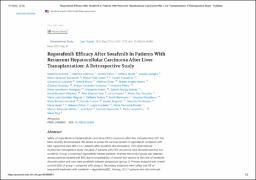| dc.contributor.author | Piñero, Federico. | |
| dc.contributor.author | Lavarone, Massimo. | |
| dc.contributor.author | Invernizzi, Federica. | |
| dc.contributor.author | Et al. | |
| dc.date.accessioned | 2023-10-17T15:34:06Z | |
| dc.date.available | 2023-10-17T15:34:06Z | |
| dc.date.issued | 2021-12 | |
| dc.identifier.citation | Liver Transpl . 2021 Dec;27(12):1767-1778. | es |
| dc.identifier.issn | 1527-6473 | |
| dc.identifier.uri | https://riu.austral.edu.ar/handle/123456789/2325 | |
| dc.description | Disponible en: https://journals.lww.com/lt/abstract/2021/12000/regorafenib_efficacy_after_sorafenib_in_patients.13.aspx | es |
| dc.description.abstract | Abstract
Safety of regorafenib in hepatocellular carcinoma (HCC) recurrence after liver transplantation (LT) has been recently demonstrated. We aimed to assess the survival benefit of regorafenib compared with best supportive care (BSC) in LT patients after sorafenib discontinuation. This observational multicenter retrospective study included LT patients with HCC recurrence who discontinued first-line sorafenib. Group 1 comprised regorafenib-treated patients, whereas the control group was selected among patients treated with BSC due to unavailability of second-line options at the time of sorafenib discontinuation and who were sorafenib-tolerant progressors (group 2). Primary endpoint was overall survival (OS) of group 1 compared with group 2. Secondary endpoints were safety and OS of sequential treatment with sorafenib + regorafenib/BSC. Among 132 LT patients who discontinued sorafenib included in the study, 81 were sorafenib tolerant: 36 received regorafenib (group 1) and 45 (group 2) received BSC. Overall, 24 (67%) patients died in group 1 and 40 (89%) in group 2: the median OS was significantly longer in group 1 than in group 2 (13.1 versus 5.5 months; P < 0.01). Regorafenib treatment was an independent predictor of reduced mortality (hazard ratio, 0.37; 95% confidence interval [CI], 0.16-0.89; P = 0.02). Median treatment duration with regorafenib was 7.0 (95% CI, 5.5-8.5) months; regorafenib dose was reduced in 22 (61%) patients for adverse events and discontinued for tumor progression in 93% (n = 28). The median OS calculated from sorafenib start was 28.8 months (95% CI, 17.6-40.1) in group 1 versus 15.3 months (95% CI, 8.8-21.7) in group 2 (P < 0.01). Regorafenib is an effective second-line treatment after sorafenib in patients with HCC recurrence after LT.
Copyright © 2021 by the American Association for the Study of Liver Diseases. | es |
| dc.language.iso | en | es |
| dc.publisher | Wiley | es |
| dc.rights | Attribution-NonCommercial-NoDerivatives 4.0 Internacional | * |
| dc.rights.uri | http://creativecommons.org/licenses/by-nc-nd/4.0/ | * |
| dc.subject | Liver transplantation | es |
| dc.subject | Carcinoma | es |
| dc.subject | Hepatocellular carcinoma | es |
| dc.title | Regorafenib Efficacy After Sorafenib in Patients With Recurrent Hepatocellular Carcinoma After Liver Transplantation: A Retrospective Study | es |
| dc.type | Article | es |


